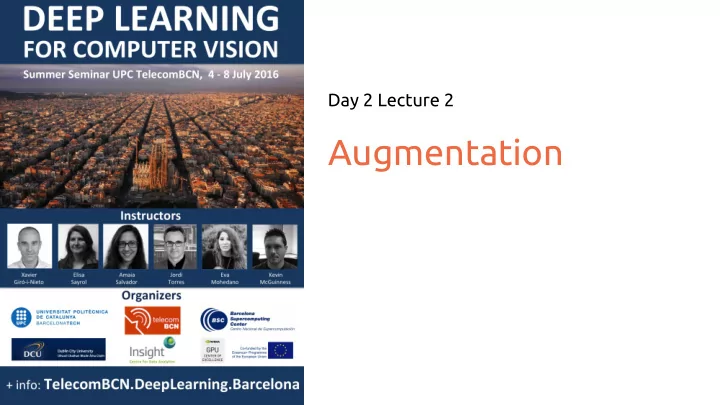

Day 2 Lecture 2 Augmentation
Introduction ImageNet Classification with Deep Convolutional Neural Networks, Krizhevsky A., 2012 ImageNet Large-Scale Visual Recognition Challenge (ILSVRC) 1.2 million training images , 50,000 validation images, and 150,000 testing images Overfitting!! Architecture of 5 convolutional + 3 fully connected = 60 million parameters ~ 650.000 neurons .
Ways to reduce overfitting ● Reduce network capacity ● Dropout ● Data augmentation
Ways to reduce overfitting ● Reduce network capacity ● Dropout 1% of total parameters (884K). Decrease in performance ● Data augmentation
Ways to reduce overfitting ● Reduce network capacity ● Dropout 37M, 16M, 4M parametes!! (fc6,fc7,fc8) ● Data augmentation
Ways to reduce overfitting ● Reduce network capacity ● Dropout ● Data augmentation Every forward pass, network slightly different. Reduce co-adaptation between neurons More robust features More interations for convergence
Ways to reduce overfitting ● Reduce network capacity ● Dropout ● Data augmentation
Data Augmentation During training, alterate the input image ( Krizhevsky A., 2012 ) - Random crops on the original image - Translations - Horitzontal reflections - Increases size of training x2048 - On-the-fly augmentation During testing - Average prediction of image augmented by the four corner patches and the center patch + flipped image. (10 augmentations of the image)
Data Augmentation Alternate intensities RGB channels intensities PCA on the set of RGB pixel throughout the ImageNet training set. To each training image, add multiples of the found principal components Object identity should be invariant to changes of illumination
Augmentation for discriminative unsupervised feature learning Discriminative Unsupervised Feature Learning with Exemplar Convolutional Neural Networks, Dosovitskiy, A., 2014 MOTIVATION ● Large datasets of training data ● Local descriptors should be invariant transformations (rotation, translation, scale, etc) WHAT THEY DO ● Training a CNN to generate local representation by optimising a surrogate classification task ● Task does NOT require labeled data
Augmentation for discriminative unsupervised feature learning Generate augmented dataset: 16000 classes of 150 examples each Class k=1, with 150 examples ... Select random location k and crop 32x32 window (restrictions: region must contain objects or part of the object: high amount of gradients) Apply a transformation [translation, rotation, scalig, RGB modification, contrast modification]
Augmentation for discriminative unsupervised feature learning Generate augmented dataset: 16000 classes of 150 examples each Example of classes Example of examples for one class
Augmentation for discriminative unsupervised feature learning Classification accuracies Superior performance to SIFT for image matching.
Summary Augmentation helps to prevent overfitting It makes network invariant to certain transformations: translations, flip, etc Can be done on-the-fly Can be used to learn image representations when no label datasets are available.
Recommend
More recommend